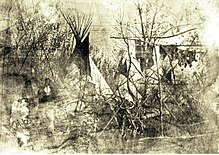
The Cheyenne are an Indigenous people of the Great Plains. Their Cheyenne language belongs to the Algonquian language family. Today, the Cheyenne people are split into two federally recognized nations: the Southern Cheyenne, who are enrolled in the Cheyenne and Arapaho Tribes in Oklahoma, and the Northern Cheyenne, who are enrolled in the Northern Cheyenne Tribe of the Northern Cheyenne Indian Reservation in Montana.

The Sand Creek massacre was a massacre of Cheyenne and Arapaho people by the U.S. Army in the American Indian Wars that occurred on November 29, 1864, when a 675-man force of the Third Colorado Cavalry under the command of U.S. Volunteers Colonel John Chivington attacked and destroyed a village of Cheyenne and Arapaho people in southeastern Colorado Territory, killing and mutilating an estimated 69 to over 600 Native American people. Chivington claimed 500 to 600 warriors were killed. However, most sources estimate around 150 people were killed, about two-thirds of whom were women and children. The location has been designated the Sand Creek Massacre National Historic Site and is administered by the National Park Service. The massacre is considered part of a series of events known as the Colorado Wars.

The Dog Soldiers or Dog Men are historically one of six Cheyenne military societies. Beginning in the late 1830s, this society evolved into a separate, militaristic band that played a dominant role in Cheyenne resistance to the westward expansion of the United States in the area of present-day Kansas, Nebraska, Colorado, and Wyoming, where the Cheyenne had settled in the early nineteenth century.

The Battle of the Washita River occurred on November 27, 1868, when Lt. Col. George Armstrong Custer's 7th U.S. Cavalry attacked Black Kettle's Southern Cheyenne camp on the Washita River.
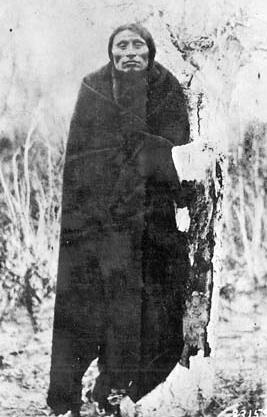
Little Wolf was a Northern Só'taeo'o Chief and Sweet Medicine Chief of the Northern Cheyenne. He was known as a great military tactician and led a dramatic escape from confinement in Oklahoma back to the Northern Cheyenne homeland in 1878, known as the Northern Cheyenne Exodus.

The Colorado War was an Indian War fought in 1864 and 1865 between the Southern Cheyenne, Arapaho, and allied Brulé and Oglala Sioux peoples versus the U.S. Army, Colorado militia, and white settlers in Colorado Territory and adjacent regions. The Kiowa and the Comanche played a minor role in actions that occurred in the southern part of the Territory along the Arkansas River. The Cheyenne, Arapaho, and Sioux played the major role in actions that occurred north of the Arkansas River and along the South Platte River, the Great Platte River Road, and the eastern portion of the Overland Trail. The United States government and Colorado Territory authorities participated through the 1st Colorado Cavalry Regiment, often called the Colorado volunteers. The war was centered on the Colorado Eastern Plains, extending eastward into Kansas and Nebraska.

Bent's Old Fort is an 1833 fort located in Otero County in southeastern Colorado, United States. A company owned by Charles Bent and William Bent and Ceran St. Vrain built the fort to trade with Southern Cheyenne and Arapaho Plains Indians and trappers for buffalo robes. For much of its 16-year history, the fort was the only major white American permanent settlement on the Santa Fe Trail between Missouri and the Mexican settlements. It was destroyed in 1849.

William Wells Bent was a frontier trader and rancher in the American West, with forts in Colorado. He also acted as a mediator among the Cheyenne Nation, other Native American tribes and the expanding United States. With his brothers, Bent established a trade business along the Santa Fe Trail. In the early 1830s Bent built an adobe fort, called Bent's Fort, along the Arkansas River in present-day Colorado. Furs, horses and other goods were traded for food and other household goods by travelers along the Santa Fe trail, fur-trappers, and local Mexican and Native American people. Bent negotiated a peace among the many Plains tribes north and south of the Arkansas River, as well as between the Native American and the United States government.

George Bird Grinnell was an American anthropologist, historian, naturalist, and writer. Originally specializing in zoology, he became a prominent early conservationist and student of Native American life. Grinnell has been recognized for his influence on public opinion and work on legislation to preserve the American bison. Mount Grinnell in Glacier National Park in Montana is named after him.
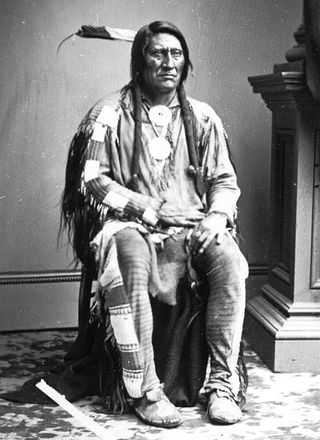
Lean Bear, alternatively translated as Starving Bear, was a Cheyenne peace chief. He was a member of the Council of Forty-four, a tribal governance devoted to maintaining peace with encroaching United States settlers. Lean Bear's most notable peace deals include the Treaty of Fort Wise and a meeting with US President Abraham Lincoln. His work towards peace between his people and the American settlers in the Southern Plains was cut short when he was killed by the 1st Colorado Cavalry Regiment and violent retaliations ensued.
Cheyenne military societies are one of the two central institutions of traditional Cheyenne native American tribal governance, the other being the Council of Forty-four. While council chiefs are responsible for overall governance of individual bands and the tribe as a whole, the headmen of military societies are in charge of maintaining discipline within the tribe, overseeing tribal hunts and ceremonies, and providing military leadership. Historically, council chiefs selected which of the six military societies would assume these duties; after a period of time on-duty, the chiefs would select a different society to take up the duties.

Edmund Gasseau Choteau Le Guerrier, of American and Cheyenne parentage, was a survivor of the Sand Creek massacre in 1864. He was an interpreter for the U.S. government during the Indian Wars between the Cheyenne and the United States, and later became a successful rancher.

George Bent, also named Ho—my-ike in Cheyenne, was a Cheyenne-Anglo who became a Confederate soldier during the American Civil War and waged war against Americans as a Cheyenne warrior afterward. He was the mixed-race son of Owl Woman, daughter of White Thunder, a Cheyenne chief and keeper of the Medicine Arrows, and the American William Bent, founder of the trading post named Bent's Fort and a trading partnership with his brothers and Ceran St. Vrain. Bent was born near present-day La Junta, Colorado, and was reared among both his mother's people, his father and other European Americans at the fort, and other whites from the age of 10 while attending boarding school in St. Louis, Missouri. He identified as Cheyenne.
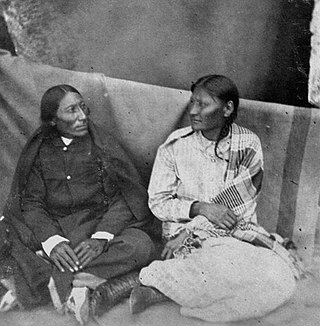
Mochi was a Southern Cheyenne woman of the Tse Tse Stus band and the wife of Chief Medicine Water. Mochi, then a 24-year-old, was a member of Black Kettle's camp and was present on the morning of November 29, 1864, when John Chivington and over 650 troops of the First Colorado Cavalry, Third Colorado Cavalry and a company of the 1st Regiment New Mexico Volunteer Cavalry attacked Black Kettle's winter camp at Sand Creek on the plains of eastern Colorado Territory.

Big Timbers is a wooded riparian area in Colorado along both banks of the Arkansas River that is famous as a campsite for Native American tribes and travelers on the Mountain Branch of the Santa Fe Trail.
Silas Bent Jr. was an American land surveyor, attorney, and jurist who served as a Judge of the Missouri Supreme Court from 1817 to 1821. His son, Charles Bent, was a fur trader and appointed as the first territorial governor of New Mexico during the United States invasion of Mexico in the Mexican-American War. Three of his other sons William, George, and Robert had been in business with Charles and built Bent's Old Fort and other outposts of trade in the American Southwest.

The early history of the Arkansas Valley in Colorado began in the 1600s and to the early 1800s when explorers, hunters, trappers, and traders of European descent came to the region. Prior to that, Colorado was home to prehistoric people, including Paleo-Indians, Ancestral Puebloans, and Late prehistoric Native Americans.
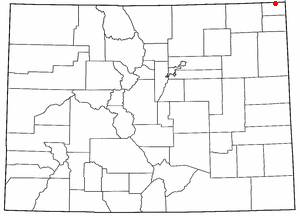
The Battle of Julesburg took place on January 7, 1865, near Julesburg, Colorado between 1,000 Cheyenne, Arapaho, and Lakota Indians and about 60 soldiers of the U.S. army and 40 to 50 civilians. The Indians defeated the soldiers and over the next few weeks plundered ranches and stagecoach stations up and down the South Platte River valley.

Amache Ochinee Prowers, also known as Walking Woman, was a Native American activist, advocate, cattle rancher, and operator of a store on the Santa Fe Trail. Her father was a Cheyenne peace chief who was killed during the Sand Creek massacre on November 29, 1864, after which she became a mediator between Colorado territorial settlers, Mexicans, and Native Americans during the 1860s and 1870s. She was inducted into the Colorado Women's Hall of Fame in 2018.

John Wesley Prowers was an American trader, cattle rancher, legislator, and businessman in the territory and state of Colorado. Married to Amache Prowers, a Cheyenne woman, his father-in-law was a Cheyenne chief who negotiated for peace and was killed during the Sand Creek massacre.





